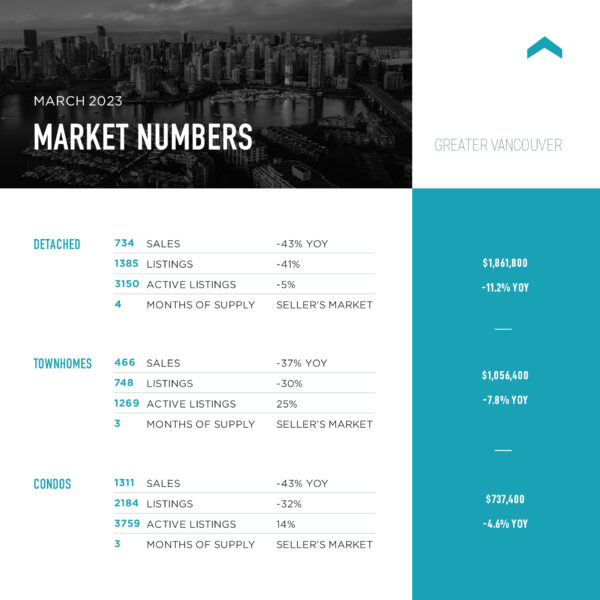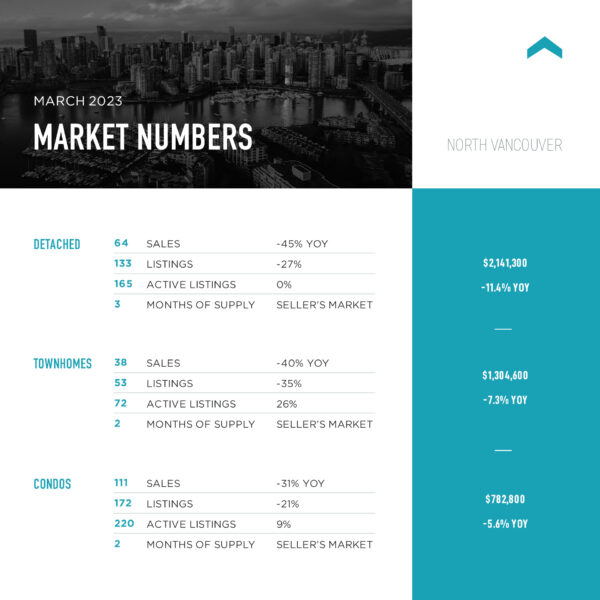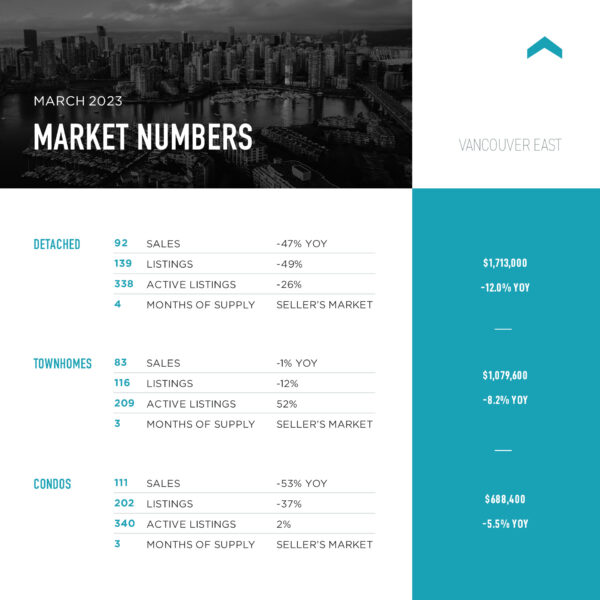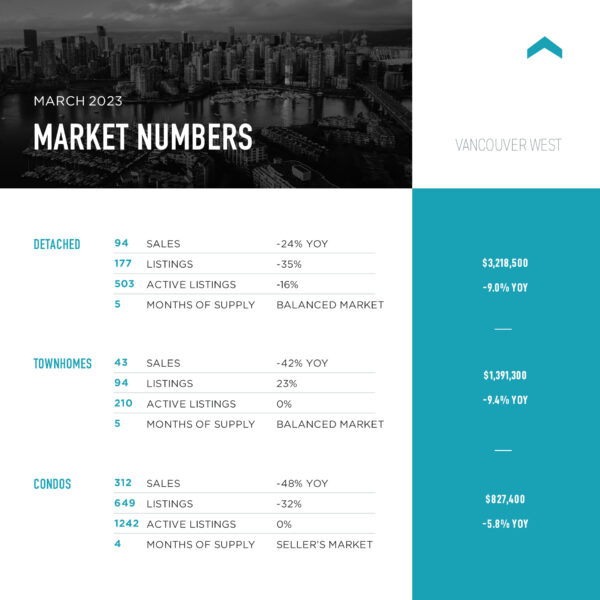March confirms momentum in Metro Vancouver housing market.
Download March Sales and Listings Statistics Houses Townhouses Condos
Download March Sales and Listings Statistics All Regional
Highlights of the March 2023 Report:
- Benchmark prices are 22% higher than three years ago
- Greater Vancouver sales are up 146% from January 2023
- Greater Vancouver Benchmark detached-house price rise $60,000+ this year
- First-time homebuyer incentive starts April 1
- Five-year fixed mortgages are now the lowest-rate option
- Fraser Valley home sales soared 72% in a month
March came in like a tiger and went out like a lion with housing sales doubling over the last two weeks of the month and a total of 2,535 sales up 38% from a month earlier and a startling 146% rebound from the 1,030 transactions in January 2023.
The composite benchmark home price increased by 3% from the end of January.
With the number of listings we have, it is a spring seller’s market with momentum.
In the Fraser Valley, sales in March were 72 percent higher than in February and, at 1,550, total transactions were above the 1,000-unit level for the first time since August of 2022. More surprising is the retreat of active listings, with detached and townhome listings down 20 to 30% year-over-year, even as much as 50% down in some pockets. This has shifted a lot of those markets to 2 to 3 months supply.
Some were surprised at the performance, including most media who are comparing the current market with last year, which is meaningless. The first quarter of 2022 was still in a once-in-a-century pandemic and the Bank of Canada had just started eight straight mortgage rate increases that spooked buyers and sellers alike.
Within the next few months, sales will begin to surpass the same month in 2022 and the headlines and perception of the current sales and price momentum will change.
The Bank of Canada’s next interest rate announcement is scheduled for April 12. It’s widely anticipated that the Bank will hold the key overnight rate at 4.5%. Also, after the April break is when lenders tend to come out with their spring mortgage promotions, which should help with the downward pressure on rates.
Fixed-rate mortgage rates are already falling. As of March 30, the lowest rates in Canada were for five-year fixed-rate mortgages at 4.29% for insured mortgages and 4.59% for uninsured home loans, according to a survey by rate.com.
Also, April 1 is the official launch of the new federal Tax-Free-Savings Account for home buyers. It allows a young couple to save up to $80,000 for the down payment on their first home on a tax-free basis. Not a huge incentive but enough to encourage some tenants into ownership.
The market has changed this spring and you can see and feel it on the street. Buyers who have come back into the Greater Vancouver market already know the score. They are seeing multiple offers on desired properties and benchmark prices that have been rising an average of $15,000 a month so far this year.
Everything is up except listings and even they will not likely stay this low for long as more sellers recognize prices are firming and buyers are back.
March saw 4,317 new listings for residential properties, which was nearly 1,000 more than in either February or January. This was a 35.5% decrease compared to the 6,690 homes listed in March 2022, however, and was 22.3% below the 10-year seasonal average. The overall sales-to-new-listing in March was 57%, which compares to the sales-success ratios during the hot market of 2021.
The total number of homes listed for sale at the end of March in Greater Vancouver was 8,617, an 8% increase compared to March of last year. Don’t be surprised to see a sudden spike in sellers this spring, since March had the lowest number of new listings for that month since 1995.
For those who are considering a sale, now is the time to list your property before the rush of new listings begins and competition for buyers increases.
It is resale listings that will deliver the most homes: Metro Vancouver’s total non-rental housing starts so far this year are just 700 units higher than in 2022.
Don’t count on the B.C. government’s latest ‘Homes for People’ plan to suddenly increase the supply or lead to lower housing prices. The plan, introduced in early April, includes automatic rezoning of every single-family lot in the province to allow up to four housing units. But this has yet to be put into legislation, so at this point, it is just a promise. We’ll have to wait until the fall to see what this may look like and the timing of it being in effect.
The City of Coquitlam has had a similar plan in place for years, allowing fourplexes, smaller lots and laneway houses in most single-detached neighbourhoods in the city since 2011.
Since then, however, the composite benchmark price of a Coquitlam detached house has increased 143%, compared to an average of 80% in the rest of Greater Vancouver; Coquitlam’s rental vacancy rate is among the lowest, at 0.7%, and the city’s rental rates are the same or higher than anywhere else in the region. Also, Coquitlam is currently sitting with just a 2 months supply of housing, mostly strata units. Clearly, the Metro region has a long way to go in adding supply if progressive Coquitlam can’t even keep up.
The B.C. plan to mandate four-plex density zoning on detached lots will increase the price of a house for rental investors or developers but it won’t deliver more homes people can buy. In the 30-page Homes for People report, strata is never even mentioned. This means house owners who opt into the plan must also become landlords, which many owners have no interest in.
The Homes for People plan is really a ‘houses for rental investors, speculators and tenants.’ This is not a bad thing, but it falls far short of the altruistic hyperbole that always surrounds such government announcements.
Bottom line: We are now at the start of the first normal market in three years. We don’t have ultra-low ‘quantitative easing’ interest rates; the sales-to-listing ratio is becoming balanced; and prices and sales are steadily increasing. All we now need is back-to-normal listings, which, hopefully, we can move toward this spring.
March 2023 report on regional markets:
Greater Vancouver: This is now a near-classic seller’s market. Greater Vancouver is down to a mere 3-month supply of townhouses and apartments available for sale, while detached houses are at a 4-month supply. Something to note: the benchmark composite home price is now 22% higher than it was three years ago when the global pandemic began. Detached sales improved significantly in March, in some areas leading in comparison to last month. While strata units were in seller’s market conditions last month, detached has also shifted to a seller’s advantage, based on current inventory levels. The benchmark price for all residential properties is currently $1,143,900. This represents a 1.8% increase compared to February 2023. The March benchmark detached house price is $1,861,800, up 2.7% – or about $50,000 – from a month earlier. “On the pricing side, the spring market is already on track to outpace our 2023 forecast, which anticipated modest price increases of about 1% to 2% across all product types,” noted Andrew Lis, director of economics and data analytics for the Real Estate Board of Greater Vancouver.
Fraser Valley: Total housing sales in March posted a 72.6% increase from a month earlier and the 1,550 transactions marked the first-time monthly sales topped 1,000 since August 2022. New listings, at 2,559, were 32% higher than in February, but still 44% below last year, while active listings were up 2.8% over last month. However, listings remain among the lowest March level in a decade. The Fraser Valley Real Estate calls it a week seller’s market, with the overall sales ratio at 31% and townhouse sales-to-listing ratio at 62%. Benchmark prices for detached houses increased 1.9% month-to-month, to $1,390,600. Townhouses were up 2.3% from February, at $794,400; and condo apartments reached $521.800 also, up 2.3% from a month before.
Vancouver Westside: Multiple offers are back in the most-watched market as sales of detached houses in March were the highest since March 2022 and benchmark prices shot up 3.7% from February 2023, to $3,218,500. With 94 sales from 177 listings, the sales ratio was 57% in this seller’s market. Total March residential sales were 449, up 42% from February 2023, and 131% higher than in January 2023. Active listings were at 1,977 at month-end compared to 2,065 at that time last year and 1,923 at the end of February; new listings in March were up 29% compared to February 2023. The supply of total residential assets for sale is down to 4 months and the overall sales-to-listings ratio is 49% compared to 44% in February 2023 as the Westside readies for an active spring.
Vancouver East Side: March sales were 143% higher than in January 2023 and 45% above February 2023, at 287 transactions. With total supply down to 899 properties and new listings up 20% from February, we are calling this a seller’s market. The sales-to-new-listing ratio in March was 62%, compared to 68% a year ago. The benchmark detached house price was up 2.1% from February 2023 and the benchmark price rose 1.7%, month-over-month to $1,135,500. Condo sales led the market in March, with 111 transactions at a median price of
$665,000.
North Vancouver: New listings didn’t last long in March, with a 72% sales-to-listing ratio and total sales of 215 properties, led by 111 condo apartment sales at a benchmark of $782,800, a price up 2.5% from a month earlier. Townhouses are benchmarked at $1,304,000 with detached houses at $2,141,300, both marginally higher than in February. Total new listings rose 45% from a month earlier, but with sales up 44% month-over-month, a 58% sales-to-listing ratio and prices rising across the board, this remains a strong seller’s market.
West Vancouver: Since the first of this year, 135 homes have sold in West Vancouver and 64 of them sold in March when sales were up 129% from January. But new listings were up just 6% from February and the total inventory of 463 properties represents about a 7-month supply. This buyer’s market is seeking balance with a sales ratio of 39% and the benchmark home price at $1,274,300, up 2.2% from February 2023 but 8% lower than in March 2022. Looking for a deal? West Vancouver’s detached house prices are down 9% from a year ago, at $3,019,500.
Richmond: Richmond posted the largest month-over-month house price increase in the region, with March detached house prices up 6.6% from February to $2,108,100. Total sales were also much higher, rocketing up 55% from a month earlier. Detached sales were up 50% at 95 transactions. Richmond is a seller’s market on steroids, with a sales-to-new-listing ratio of 74%, compared to 49% in February and 63% in March of last year, and total inventory is down to three months.
Burnaby East: Modest increases in home sales, up 5% from February to just 20 transactions in March, compared to a 135% increase in listings would normally signal a buyer’s market. But with just a two-month supply of total active listings and a 43% sales-to-listing ratio, we are calling this to the seller’s advantage. The benchmark home price in March was $1,156,600, up 2.2% from a month earlier but down more than 10% from the same month last year.
Burnaby North: Detached house prices edged up 2% from February to $1,878,200 in March, the highest increase in Burnaby but still 10% below March 2022. Townhouse and condo prices were virtually unchanged from February 2023. This is a seller’s market with a sales-to-new-listing ratio of 71% and just a two-month supply on the market. There are 388 active listings on the market, with new listings up 17% from February 2023. Total sales in March tallied 169 transactions, the highest level so far this year.
Burnaby South: Total sales have been rising month-over-month in the first quarter and reached 130 in March, at a benchmark home price of $1,075,100. This remains a seller’s market, though sales are still down 40% from a year ago and prices are 8.5% lower. Active listings were 408 at month-end compared to 395 at that time last year and 377 at the end of February. Total listings are steady at 3 month’s supply and the sales-to-listings ratio of 55% compares to 57% in February 2023 and 59% in March 2022.
New Westminster: There is a wide price spread for condo apartments in New Westminster, where the condo benchmark price is $648,000. Dig down and you will find the median condo price varies from a low of $455,000 in the West End of the Royal City to $522,000 in the uptown and peaked at $885,000 in Queensborough, based on March sales stats. That is why it is a good idea to have a knowledgeable real estate agent to guide you if you are a new buyer in historic New West. The overall market is active, with total sales of 96 in March, which was 140% higher than in January 2023 and up 46% from February. This is a seller’s market still, with a sales-to-listing ratio of 68% and just 229 properties on the market.
Coquitlam: As noted above, Coquitlam was a pioneer in up-zoning detached homes to create more housing units per lot, which the city started in 2011, and the BC government now wants to mandate across the province. The rather unsettling result is that, 12 years later, Coquitlam has only a 2-month supply of homes with just 428 on the market as of the end of March. And sales are increasing, with March transactions rising 24% from a month earlier and up 169% since January, to 196.
The benchmark price is up 2% from the start of the first quarter, at $1,065,800. This is a seller’s market, with a 64% sales-to-listing ratio, which is higher than in March 2022, and prices rising for all property types.
Port Moody: The first master-planned residential community approved and moving forward since 2004 is now pre-selling in Port Moody. The 23-acre, $1.1 billion Portwood development, by Edgar Development, includes 2,000 strata homes and about 470 rentals in the Woodland Park area. The new homes are badly needed as other new projects remain stalled and there is barely a 2-month supply of resales on the market. With total sales of 80 in March, up 70% from a month earlier, the benchmark price is up 2.4% so far this year to $1,105,200 and detached houses are selling at a benchmark of $2,107,400, up 2.4% from a month earlier. The sales-to-listing ratio is high at 70%, nearly the same as a year ago. (Incidentally, the cost for the developer to deliver Portwood included $2.85 million in public art; $30 million for a new road; 328 low-rent housing units for BC Housing, and donating 70% of the land for green space.
Port Coquitlam: Like Coquitlam, Port Coquitlam also has a plan of “gentle density” to add more housing units on detached lots. However, only 66 new homes have started in the entire Tri-Cities market so far this year. Port Coquitlam has seen housing sales double so far this year, to 69 in March and the benchmark home price is up 3.1% since January at $915,700, which is still down nearly 12% from a year ago. The sales-to-new-listing ratio in March was a balanced 54% as this seller’s market readies for the spring buying season with a total of 160 properties on the market.
Pitt Meadows: Total March sales were up 87% compared to both January and February, to 28 transactions, as the residential benchmark price edged up 2.5% from February to $846,500. This price remains 20% below March 2022. With a total of 69 active listings and a sales ratio of 65%, this is a seller’s market, but March saw a 59% increase in new listings from February, so buyer selection is improving.
Maple Ridge: Maple Ridge benchmark prices also remain nearly 20% below a year ago, with detached houses selling for $1,179,500 in March, up a modest 1.1% from the first of this year. There was a total of 149 homes sold in March, 129% higher than in January and up 16% from February. With 495 active listings on the market and 54% of new listings selling in March, this is a steady seller’s market. Buyers may want to look at townhouses, now selling for $731,700, the lowest price in the Greater Vancouver mainland market, and down 19% from March 2022.
Ladner: Ladner continues to struggle for townhouse and condo listings, with townhouses only having 1 month supply and a 92% absorption rate and condos seeing the most sales since October 2021. In March, total sales of all property types were up 138% from January and the sales-to-listing ratio hit 55%. But this is not a balanced seller’s market, with townhouse prices up a market-leading 8.6% since the first of the year, to $998,500; and condo prices up 6.5% in the same period to $714,300. The supply of total residential listings is down to a 3-month inventory at the current sales pace.
Tsawwassen: Sunny Tsawwassen turned on the heat in March, with housing sales up 40% from a month earlier to 35 units. The strata market is sizzling, with townhouse benchmark prices rising 11.5% since January 1, to just over $1 million; and condo prices up 6.6% in the same period to $740,600 – a price slightly above March 2022 and 37% higher than even three years ago. This is pegged as a balanced market with a sales-to-listing ratio of 43%, but sellers are fully in control of the tight townhouse and condo sector.
Surrey: The city posted an 84.8% increase in detached-house sales in March compared to a month earlier, with the composite benchmark price unchanged at $1,503,200, though still down 19.5% from March 2022. Townhouse sales were up 59% from February and condo sales rose 48%, month-over-month, to 217 transactions at an average price of $536,054. With active listings, sales and prices rising this year in every market from North Surrey to South Surrey-White Rock, B.C.’s second-biggest city is shaping up as a very active spring market, with buyers holding a slight edge.
